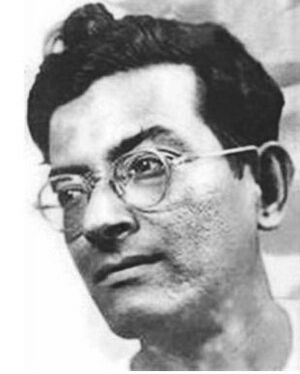Manik Bandopadhyay facts for kids
Quick facts for kids
Manik Bandyopadhyay
|
|
|---|---|
 |
|
| Born |
Prabodhkumar Bandyopadhyay
19 May 1908 Dumka, Bengal Presidency, British India
|
| Died | 3 December 1956 (aged 48) Kolkata, West Bengal, India
|
| Nationality | Indian |
| Occupation | Writer |
| Spouse(s) | Kamala Bandyopadhyay |
Manik Bandyopadhyay (born Prabodh Kumar Bandyopadhyay; 19 May 1908 – 3 December 1956) was a famous Indian writer. He is known as one of the most important figures in Bengali literature during the 20th century.
Manik Bandyopadhyay wrote many amazing novels and short stories. He also wrote some poems and essays. He faced health challenges and financial difficulties throughout his life. Even so, he created many masterpieces. One of his stories was even made into an early film in Pakistan called The Day Shall Dawn.
Contents
Early Life and Influences
Manik Bandyopadhyay was born on 19 May 1908. His birthplace was Dumka, a small town in what was then Bihar, British India. Today, Dumka is part of Jharkhand. His family was Bengali Brahmin. His parents were Harihar Bandyopadhyay and Niroda Devi.
He was named Prabodh Kumar. But everyone knew him by his nickname, Manik. He was the fourth of fourteen children, though only ten survived. His father worked for the government. This meant the family moved to many different places. They lived in various parts of Bengal, Orissa, and Bihar.
Moving around helped Manik see how people lived. He saw the joys and struggles of people in both cities and villages. These experiences deeply influenced his writing. He often wrote about the lives of ordinary people. Manik was also a romantic person. He loved to sing and play the flute.
Becoming a Writer
Manik loved literature from a young age. He read many great Bengali books. When he was in Class VII, his Bengali teacher was very impressed with his writing. The teacher often told other students to learn from Manik. He even started writing poetry when he was sixteen.
Manik was a very smart student. He went to the famous Presidency College in Kolkata. There, he studied mathematics. One day, his classmates said that only famous writers could get their stories published. Manik disagreed. He made a bet that his first story would be good enough.
He wrote his first story, "Atasimami" (Aunt Atasi). It was a romantic story about an older couple. Manik took it to the office of a well-known magazine called Bichitra. He simply handed it over and left. After waiting for about four months, something amazing happened. The famous editor of the magazine came to his home! The editor brought him a copy of the magazine with "Atasimami" published. He also gave Manik money and asked for another story.
"Atasimami" caused a stir in the literary world. Manik became less focused on his studies. He didn't finish his degree. Instead, he decided to become a full-time writer. He worked hard to support his family, including his wife Kamala Bandyopadhyay.
Social Views
Manik Bandyopadhyay was very interested in social ideas. He read books by thinkers like Freud and Marx. He also took part in cultural events and movements for working people. In 1944, he joined the Communist Party of India. He remained a member until he passed away.
His Works
Manik Bandyopadhyay had a writing career that lasted 28 years. During this time, he wrote a lot! He wrote 38 novels and 306 short stories. This includes 32 stories for young readers. He also wrote one play, one book of poems, and one book of essays about literature.
Manik wrote his first novel, Dibaratrir Kavya (Poetry of the Day and Night), when he was 21. Some of his most famous novels include:
- Janani (Mother), published in 1935
- Dibaratrir Kavya, also from 1935
- Putul Nacher Itikatha (The Puppets’ Tale), 1936
- Padma Nadir Majhi (Boatman of the River Padma), 1936
- Shahartoli (Suburbia), published in two parts in 1940 and 1941
- Chatushkone (Quadrangle), 1942
- Chinha (Signs), 1947
- Halud Nadi Sabuj Bon (Yellow River Green Forest), 1956
He also had 16 books of short stories published. Some of his well-known short stories are:
- "Sailaja Shila" ("Rocky Rocks")
- "Pragoitihasik" ("Primeval")
- "Sarishrip" ("Reptiles")
- "Haludpora" ("Burnt Turmeric")
- "Namuna" ("A Sample")
- "Aaj Kal Porshur Galpo" ("Today, Tomorrow and Day After")
- "Shilpi" ("Craftsman")
- "Haraner Natjamai" ("Haran's Grandson-in-Law")
- "Chhotobokulpurer Jatri" ("Travelers to Chhotobokulpur")
- "Upay" ("The Way-out")
Two other important books of his works were published after his death. These include Manik Bandyopadhyayer Kavita (Poems of Manik Bandyopadhyay) in 1970. Also, Samagra Prabandha Ebong (Complete Essays) came out in 2015.
Movies Based on His Stories
Many of Manik Bandyopadhyay's stories have been made into movies. Here are some of them:
- The Day Shall Dawn (1959), a Pakistani movie
- Dibratrir Kabya (1970), an Indian film
- Calcutta 71 (1972)
- Choto Bakulpurer Jatri (1987)
- Jake Ghoosh Dite Hoy
- Padma Nadir Majhi (1992)
- Shilpi (1994)
- Mayar Jonjal (2023)
Translated Works
Manik Bandyopadhyay is one of the few Bengali writers whose works have been translated into many languages. His famous novel Padma Nadir Majhi (Boatman of The Padma) has been translated into 7 or 8 Indian languages. It has also been translated three times into English. Plus, it's available in Swedish, Czech, Hungarian, Chinese, Bulgarian, Russian, Slovak, Dutch, German, French, and Italian.
Another important novel, Putul Nacher Itikatha (The Puppets’ Tale), has been translated into 11 or 12 Indian languages. You can also read it in English, Czech, and Hungarian. His novel Chinnha (Signs) is available in Assamese, English, and Czech. The novel Darpan (Mirror) was translated into Hindi. Many of his short stories, almost 70, have also been translated into different languages around the world.

